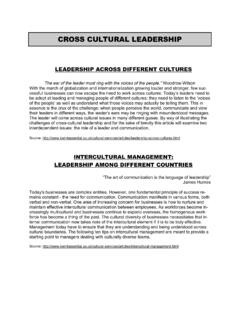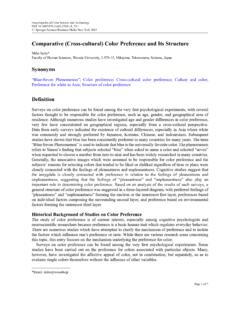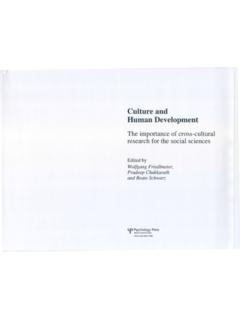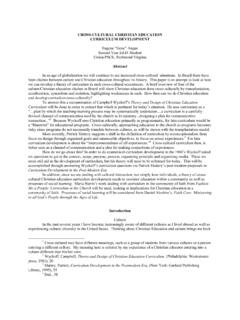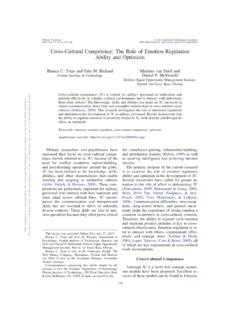Transcription of THE CROSS-CULTURAL LEADER: THE …
1 Journal of International Business and cultural Studies The CROSS-CULTURAL Leader, Page 1 THE CROSS-CULTURAL LEADER: THE APPLICATION OF SERVANT LEADERSHIP THEORY IN THE INTERNATIONAL CONTEXT Maureen Hannay Troy University ABSTRACT Leadership theories have evolved from a focus on traits, to behaviors, to contingency theories, to more contemporary approaches including servant leadership theory. This paper provides an overview of the principles of servant leadership and identifies characteristics displayed by servant leaders in the workplace, with special emphasis on the importance of empowerment in defining a servant-leader. It also addresses the application of servant leadership in a CROSS-CULTURAL context utilizing Hofstede s five cultural dimensions as a framework. This paper concludes that servant leadership is best applied in a culture with low power distance, low to moderate individualism, low to moderate masculinity, low uncertainty avoidance and a moderate to high long-term orientation.
2 Key Words: Servant Leadership, Hofstede s cultural dimensions, CROSS-CULTURAL management, empowerment, leadership styles Journal of International Business and cultural Studies The CROSS-CULTURAL Leader, Page 2 Introduction Leadership has been and continues to be a topic of considerable interest in the management literature. While there is no universal definition of leadership, there is agreement on the fact that leadership involves an influencing process between leaders and followers to ensure achievement of organizational goals. Early studies in the area of leadership focused mainly on trait theories in the hopes of identifying the personality characteristics of the ideal leader. When they proved unsuccessful, research moved on to the examination of behaviors that would differentiate leaders from followers. But again, researchers were unable to define a universal theory of leadership. Contingency theories, which essentially said that the most effective leadership style depended on the situation, the followers, and the leaders , replaced the search for the one best leadership style.
3 More recent research has focused on charismatic and transformational theories of leadership. This paper discusses the application of another contemporary theory of leadership, servant leadership theory, and examines its application in the CROSS-CULTURAL context. An Overview of Servant Leadership Before discussing the CROSS-CULTURAL applications of servant leadership an overview of the basic philosophy and tenets behind the servant leadership model is necessary. In 1977 Robert Greenleaf introduced the concept of servant leadership. According to Greenleaf (1977) servant- leaders are driven to serve first, rather than to lead first, always striving to meet the highest priority needs of others. Greenleaf identified the principal motive of the traditional leader as being the desire to lead followers to achieve organizational objectives. On the other hand, the driving motivation of a servant-leader is to serve others to be all that they are capable of becoming.
4 De Pree (1989) defines the nature of servant leadership as serving not leading. By serving others, leaders lead other people to the point of self-actualization. While most traditional leadership theories are behaviorally based, servant leadership emerges from a leader s principles, values, and beliefs (Walker, 2003, p. 25). Before publishing his seminal work on servant leadership, Greenleaf spent 40 years in the business world as an executive at AT&T (Spears, 1996). Therefore his leadership model combined theoretical as well as practical principles regarding the most effective methods of influencing and developing followers. However, Greenleaf was certainly not the first to introduce the concept of servant leadership. Its origins are clearly traced back to the bible and stories of Jesus Christ. Service to followers is demonstrated in many of the acts Christ performed, most famously by his washing the feet of his disciples. In defining his servant leadership theory, Spears explains that Greenleaf was also influenced by a short novel, Journey to the East, written by Herman Hesse.
5 Hesse s book is the story of a mythical journey by a group of people on a spiritual quest. The central figure of the story is Leo, who accompanies the party as their servant, and who sustains them with his caring spirit. All goes well with the journey until one day Leo disappears. The group quickly falls apart, and the journey is abandoned. They discover that they cannot make it without the Journal of International Business and cultural Studies The CROSS-CULTURAL Leader, Page 3 servant, Leo. After many years of searching, the narrator of the story stumbles on Leo and is taken into the religious order that had sponsored the original journey. There, he discovers that Leo, whom he had first known as a servant, was in fact the head of the order, its guiding spirit, and a great and noble leader (Spears, 1996, p. 33). Spears reports that Greenleaf concluded that the great leader is first experienced as a servant to others, and he believed that true leadership emerges from those whose primary motivation is a deep desire to help others.
6 Greenleaf (1977) asserted that servant- leaders put the needs and interests of others above their own. They make a deliberate choice to serve others. However, this should not be associated with a low self-concept or low self-esteem. A strong self-image, moral conviction, and emotional stability are factors that drive leaders to make this choice (Sendjaya & Sarros, 2002). The servant-leader seeks to make sure that other people s highest-priority needs are being served. Servant- leaders seek to transform their followers to ..grow healthier, wiser, freer, more autonomous, and more likely themselves to become servants (Greenleaf, 1977, pp. 13-14). Characteristics of Servant- leaders After reviewing the literature, Russell and Stone (2002, p. 146) described 20 characteristics that researchers in this field have consistently identified as being associated with servant- leaders . The first list comprises what they termed functional attributes due to their repetitive prominence in the literature.
7 These functional attributes are the characteristics and distinctive features belonging to servant- leaders and can be observed through specific leader behaviors in the workplace: 1. Vision 6. Modeling 2. Honesty 7. Pioneering 3. Integrity 8. Appreciation of others 4. Trust 9. Empowerment 5. Service The remaining characteristics are identified as accompanying attributes of servant leadership: 1. Communication 6. Influence 2. Credibility 7. Listening 3. Competence 8. Encouragement 4. Stewardship 9. Teaching 5. Visibility 10. Delegation Russell and Stone assert that these accompanying attributes are not secondary in importance; instead they are complementary and may even be prerequisites to effective servant leadership. Pollard concludes (1997, pp. 49-50) that a real leader is not the ..person with the most distinguished title, the highest pay, or the longest the role model, the risk taker, the servant; not the person who promotes himself or herself, but the promoter of others.
8 Journal of International Business and cultural Studies The CROSS-CULTURAL Leader, Page 4 Empowerment One characteristic that continues to receive considerable attention in the leadership literature in general and in servant leadership in particular, is empowerment. Gibson, Ivancevich, Donnelly and Konopaske (2006, p. 500) define empowerment as granting individuals the permission to utilize their talents, skills and resources, and experience to make decisions to complete their workloads in a timely manner. In many cases this means employees are making decisions about their work that were previously the domain of management. Managers must relinquish the traditional means of power and delegate some decision-making responsibilities to employees (Pollard, 1996). This involves entrusting workers with authority and responsibility (Costigan, Ilteer, & Berman, 1998). Empowerment is a key concept in servant leadership (see Russell & Stone, 2002, p. 152 for an extensive list of authors supporting this premise).
9 Bass (2000) stresses that servant leadership encourages follower learning, growth, and autonomy, which are all nurtured through empowerment. Servant- leaders respect the capabilities of their followers and enable them to exercise their abilities, share power, and do their best (Oster, 1991; Russsell, 2001; Winston, 1999). The servant-leader is prepared to share power through empowerment, thereby involving followers in planning and decision making (Bass, 1990). Manz (1998, p. 99) stated that, Wise leaders lead others to lead themselves , which ultimately leads to a decentralized organizational structure that focuses on information and power sharing. Many managers struggle with the processes of empowerment and delegation (Argyris, 1998; Sanders, 1994), but these are essential behaviors of the servant-leader. Covey (2006, p. 5) quotes Greenleaf as saying: The only authority deserving our allegiance is that which is freely granted by the led to the leader in proportion to the servant stature of the leader.
10 Thus the leader gains power by exercising his or her servant qualities such as empowerment and service, rather than the traditional view that power sharing will diminish his or her ability to influence followers. Transformational versus Servant Leadership Parallels have been drawn between transformational leadership and servant leadership. Stone, Russell and Patterson (2004, p. 354) identify numerous analogous characteristics between the two theories including: influence; vision; trust; respect/credibility; risk-sharing/delegation; integrity; and modeling. They posit that this is because both transformational and servant leadership are attempts to define and explain people-oriented leadership styles. However, they identify one essential element that differentiates the two theories. Stone et al. state that, While transformational leaders and servant- leaders both show concern for their followers, the overriding focus of the servant-leader is upon service to followers.











